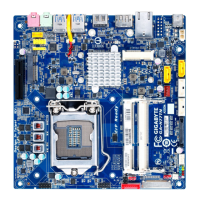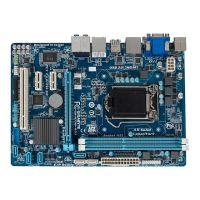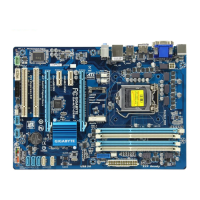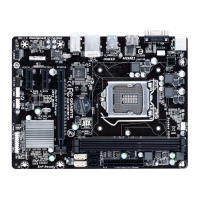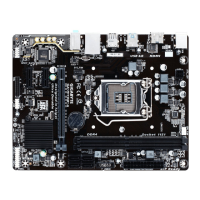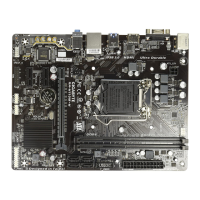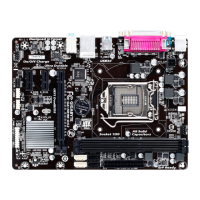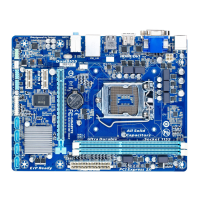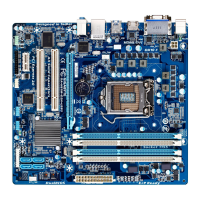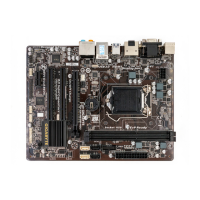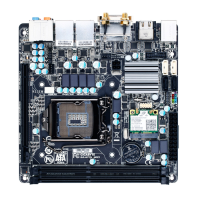
Do you have a question about the Gigabyte GA-H77N-WIFI and is the answer not in the manual?
| Memory voltage | 1.5 V |
|---|---|
| Memory channels | Dual-channel |
| Memory slots type | DIMM |
| Number of memory slots | 2 |
| Supported memory types | DDR3-SDRAM |
| Maximum internal memory | 16 GB |
| Supported memory clock speeds | 800, 1066, 1333, 1600 MHz |
| Processor socket | LGA 1155 (Socket H2) |
| Processor manufacturer | Intel |
| Compatible processor series | Intel Celeron, Intel Pentium |
| CPU fan connector | Yes |
| Number of Parallel ATA connectors | 0 |
| USB 3.2 Gen 1 (3.1 Gen 1) connectors | 1 |
| USB 2.0 ports quantity | 4 |
| Audio chip | Realtek ALC892 |
| Component for | PC |
| Power source type | ATX |
| Motherboard chipset | Intel H77 |
| Audio output channels | 7.1 channels |
| Motherboard form factor | mini ITX |
| Compatible operating systems | Windows 8/7/XP |
| Supported storage drive interfaces | SATA II, SATA III |
| Parallel processing technology support | - |
| Networking features | Gigagit Ethernet, WLAN |
| Ethernet interface type | Gigabit Ethernet |
| BIOS type | EFI AMI |
| Bundled software | Norton Internet Security (OEM version), Intel Rapid Start Technology, Intel Smart Connect Technology, Intel Smart Response Technology |
| Width | 170 mm |
|---|
Provides essential safety and handling guidelines for motherboard installation to prevent damage.
Details the technical specifications of the motherboard, including CPU, memory, and ports.
Step-by-step guide for installing the CPU and its cooler, including alignment and thermal grease application.
Instructions for installing memory modules, including dual-channel configuration.
Covers the process of installing expansion cards into PCI Express slots.
Describes the various connectors available on the motherboard's back panel.
Details the internal connectors on the motherboard for system components.
Explains the initial screen displayed when the computer boots and associated function keys.
Overview of the BIOS Setup program's main menu, including 3D BIOS and standard interface.
Provides information and settings related to system performance tuning.
Information about CPU, memory, motherboard model, and BIOS version; system language and time settings.
Configures various system features, including boot options, security, and virtualization.
Configures onboard peripherals such as SATA controllers, USB, audio, and LAN.
Configures system power saving features and wake-up options.
Options for saving BIOS changes, exiting without saving, loading defaults, and boot overrides.
Guides on installing essential chipset drivers for motherboard functionality and performance.
Lists and describes GIGABYTE utilities and free software available for installation.
Instructions for installing drivers and utilities for the motherboard's Wi-Fi functionality.
Introduces GIGABYTE's BIOS update tools: Q-Flash and @BIOS, and DualBIOS design.
Describes the EasyTune 6 utility for system tuning, overclocking, and fan control in Windows.
Explains the Q-Share utility for sharing data over a network using the computer.
Guides on setting up RAID-ready systems and using X.H.D for RAID array management.
Introduces Auto Green, a tool for system power saving using a Bluetooth cell phone.
Covers EZ Setup utilities like EZ Smart Response, EZ Rapid Start, and EZ Smart Connect.
Explains how to use the Wi-Fi Share utility in Virtual Router, Wi-Fi Share, and Wi-Fi modes.
Describes using the Cloud Station utility with iOS apps for remote system control and file sharing.
Covers configuring SATA controllers, setting up RAID arrays, and installing drivers.
Guides on installing SATA RAID/AHCI drivers and the operating system (Windows 7/XP).
Details on configuring audio jacks, speaker setups, and microphone recording.
Information on connecting and configuring S/PDIF Out for digital audio transmission.
Steps to connect and configure a microphone for recording audio.
Guide on using the Sound Recorder application to record and play audio.
Addresses common user questions regarding keyboard, audio, and driver installation issues.
A flowchart-based guide to diagnose and resolve system startup problems.
Contains regulatory notices, RoHS, and WEEE statements regarding product compliance and disposal.
